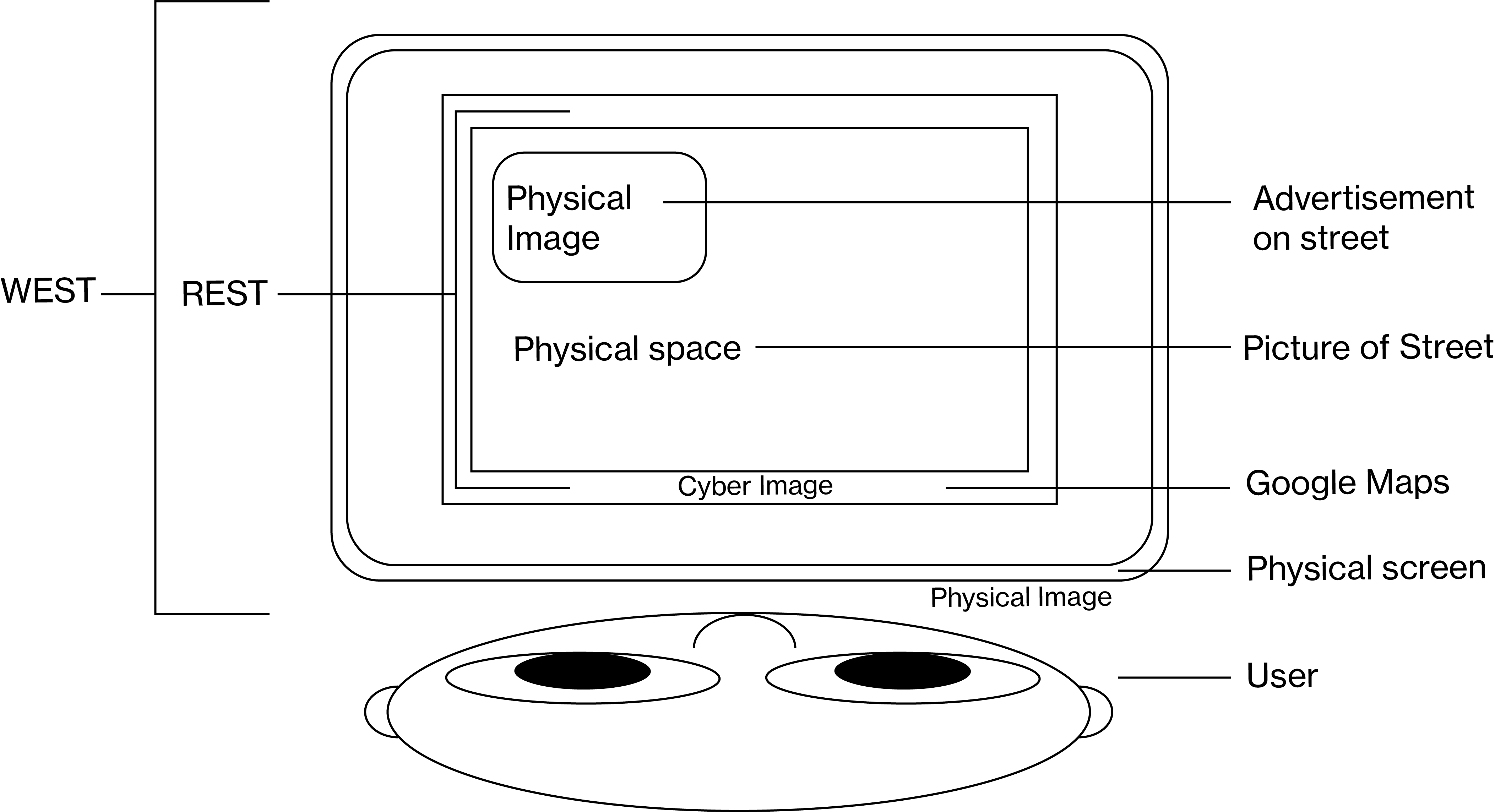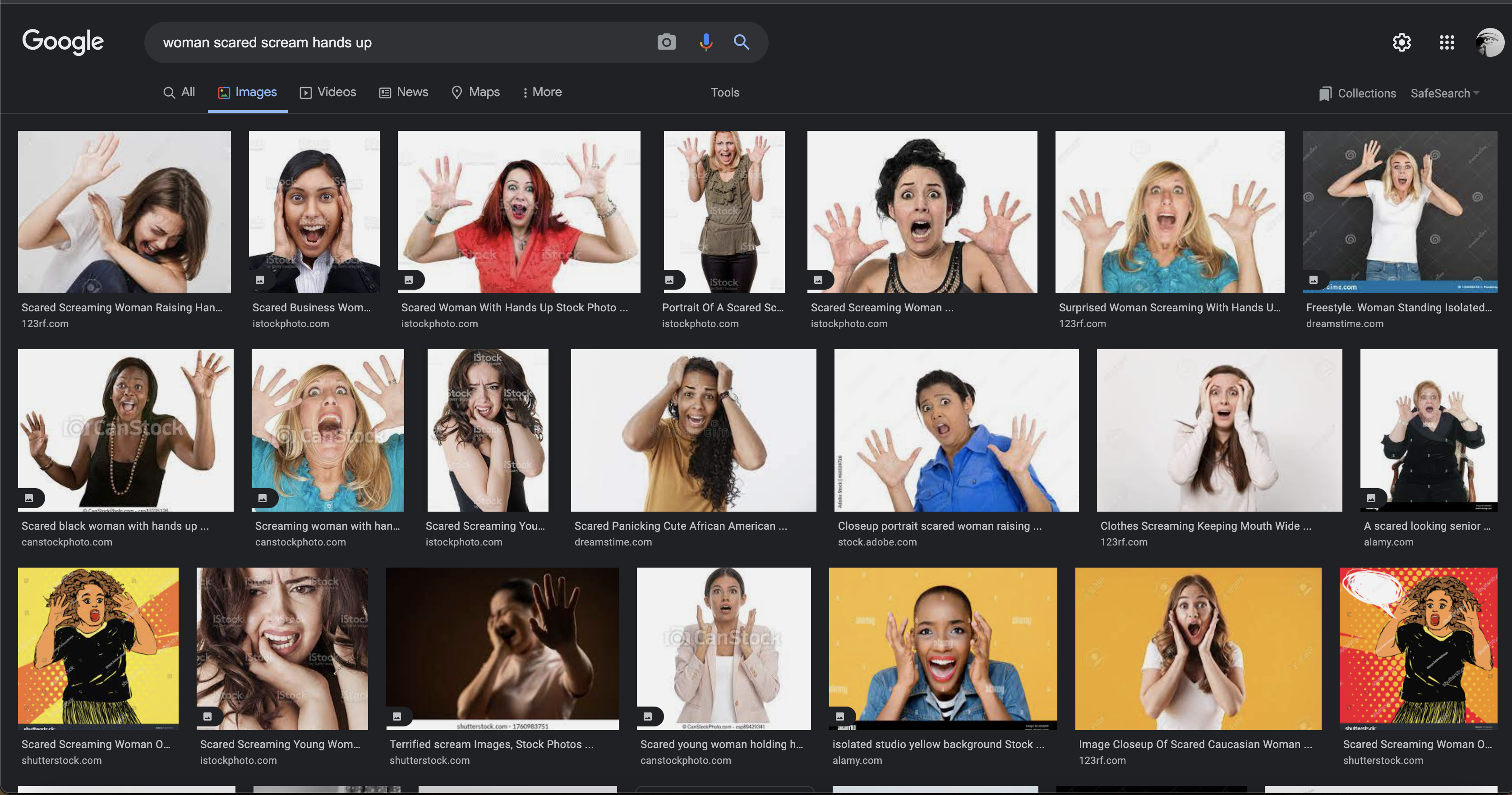1
Two definitions for describing visual phenomena have been developed throughout this thesis. They both reflect on the visual consequences of theoretical issues.Cyber West:
noun
the cyberspace visually dominated by hegemonic western ideals.
It is commonly used as a tool of Digital Colonialism and Neocolonialism.
Neoliberal Landscapes:
noun
Physical spaces that exhibit the domination of neoliberalism and Eurocentric ideals through the discrepancy between its visual culture and its demographic context.
2
I believe that the use of the cyber west as a tool for decolonization
has been exemplified in virtue of the methodology practised in this research. Using
cyber-western technologies, access to physical spaces that exhibit visual
neocolonialism in the global south is available. Consequently, the use of the
digitalized realities of Google facilitates deeper visual introspection and
awareness by providing online access to non-western physical realities (fig. 29).

Figure 29. Physical image in cyber image in physical image.
Reflective note: The realities translated into the cyber west, are still controlled, and curated by the private US based company.
3
During the act of taking and archiving the visual examples of the Cyber West
manifested in the Corporeal Rest, I was encapsulated in a car. Through my intersectional
position I recognized the contrast of the realities lived in turban Guatemala,
in other words, it was quite dangerous for me to be a pedestrian. Most of the
pictures of public spaces were taken from a car–from this fact, I understood
two main things. Firstly, being a person perceived as female with a smartphone
in a public street might prove to be a fatal task–which I believe stems from
the postcolonial condition of an exploited country in the Global South. Secondly,
Guatemala City is built for the facilitation of machines, not people–naturally
one might associate this with the histories between Guatemala and the US and
their need for production. 
Figure 30. “Security and technology. Delta Elite.” Pictured on the San Cristóbal main boulevard. 2022.
Based on the previous reflection I want to highlight that this is just one factor among many others that make life in the city a neoliberal fantasy. The intricate web between postcolonialism and neoliberalism has created necessities that greatly burden citizens every day, and these circumstances are clearly reflected in the visual culture (e.g., fig. 30)–therefore visual culture itself becomes part of the burden. On the whole, numerous amounts of western visual content, combined with the lack of control on advertising display in urban Guatemalan spaces and the effects of visual saturation on the human psyche, grant the conditions for a neo-colonization of visual culture. In this context, the role of stock photography becomes an amplifier of neoliberal needs. Therefore, stock photography thus far can be addressed as a visual colonization tool, based on its hegemonic representation of reality through a western lens in addition to its globalized stand as a visual content industry.
4
As illustrated through my personal narratives, the atmosphere I grew up in was clogged with visual
pollution that mostly depicted a reality that I could not connect with and
therefore felt that my existence was somehow dismissed. In retrospect, the mass
usage and distribution of stock photography created a homogenous interpretation
of reality that targeted the subconscious. I would like to connect this with
what Frosh describes stock photography as: “Part of the background,
unremarkable, and effectively ‘invisible’, they are routinely overlooked by
most viewers, most of the time. They are the wallpaper of consumer culture.” (1).
The crux of the matter lies in the lack of acknowledgement and awareness of our
surroundings. The act of ignoring and not challenging visual phenomena like
that of stock photography in the Global South is an act of acceptance and that
passive acceptance correlates to the hegemonic systems we move by today.
Regarding visual culture, we must fight the homogenization and colonization of
visual representation, more emphatically on those that depict human diversity.5
During my scrolling journey through the Cyber West in search of the
right stock photos, I got a type of headache I had not experienced before.
Eventually, I understood that it was the effect of such an overwhelming amount
of visual stimulation–what’s more, this stimulation was accompanied by a level
of emotional exhaustion. Naturally, hundreds of images of women seeming scared (fig.
31) disturbed me to a point in which I had no choice but to cease the search
and look away. However, the images I was scrolling through were all fake–they
all came from stock photography digital banks, but my empathy was still alert. The
way in which stock photography causes emotional reactions comes from many
general cultural associations and human nature–ultimately, this effect is used to
encourage consumerism. Consequently, in association with the previous discussion
point and what Frosh stated as the wallpaper of consumer culture (1), I believe
that mental health is being constantly threatened by neoliberal visual
communication standards. The use of
constant emotional triggers in advertising may reflect the poor conditions that
the urban visual culture offers for mental health stability. Therefore, I
suggest that a great part of stock photography acts as a bank of emotional
manipulation in addition to its neocolonial effects. 
Figure 31. Google search for “Woman scared hands up”. 2022. Author’s screenshot.
6
It might be evident by this
point that most of the subjects I traced back to digital stock photography in
the research methodology had a female appearance (fig. 32).
I do not have a clear explanation, but I would like to offer a brief hypothesis.
In relation to the use of emotion as a way of advertising, discussed in the Visual Neocolonialism subchapter,
I believe that the conservative notion of female and male is used as a
manipulative tool. The female figure and character have traditionally been subject
to objectification and oppression–therefore, the gentle and complying nature associated
with women, idealized by the hegemonic patriarchal state, is a vehicle for
emotional impact for stock photography. However, I believe this would be better
explained through feminist theories.
Figure 32. Google search for “Woman head in arms”. 2022. Author’s screenshot.
7
I would also like to bring the reader’s attention to the fact that the
tools for visual neo-colonization in Guatemala did not stop with stock
photography. Throughout the research process I noticed that many images that do
not involve the nature of stock photography continued to portray the small percentage
of white people in Latin America, or as some advertising experts call them, Latino
Internationale (Sarhandi 34). Naturally, the consequences of such an
imposed phenomenon have appeared in many forms– e.g., exclusive casting, local celebrities,
social media, etc. Currently, in Guatemala, the usage of whiteness as a general
representation does not only originate from images obtained from the Cyber West.
However, the influence of the images produced within Guatemala is meant to
emulate what has been imposed for centuries by Eurocentric systems. This also
means that the ethnic diversity endorsed by those that produce new visual
materials still mirrors the Eurocentric perception. 
Figure 33. Nova MM. Homepage of Guatemalan model management website, 2022. Nova MM, www.novamodelmgmt.com. Author’s screenshot.
In this example (see fig. 33), a Guatemalan model management agency exhibits the Eurocentric perception of ethnic diversity by casting various other ethnicities other than white, but ignoring the real demography that inhabits the country, i.e., indigenous peoples.
8
The juxtaposition of the realities represented on the billboards and the
corporeal realities of Guatemala result in a dispute between “what is meant to
be” and “what it is”, thus generating neoliberal landscapes. Correspondingly, I
would like to refer to abyss thinking (Santos 2). This thinking exemplifies how
social reality is divided into two realms–the realm of “this side of the line”
and the realm of “the other side of the line” that becomes non-existent in any
relevant way of being (Santos 2). This relationship is core to the dichotomy
imposed by Western ways of thinking. Abyss thinking illustrates how one reality
cannot exist simultaneously with others (Santos 3). I believe that what I have
exemplified as neoliberal landscapes are what exists in the urban spaces beyond
the other side of the line. These landscapes visually embody the discrepancies
of the current globalized capitalist systems. With the help of visual
communication design, the pictures that manifest in the global south from the
western side of dichotomy act as portals to a dimension, a reality, and an
existence that loom from the other side, almost mockingly. Outrageously, the
nations that have been and continue to be exploited by the biggest global
economies, are burdened to play along in the neoliberal game and construct
their own western realities with the scraps of what resources have not been
digested by the hegemonies. ︎︎︎ Previous Chapter Next Chapter ︎︎︎
